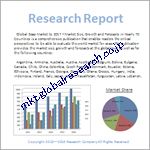目次
第1章 世界の教育AI市場エグゼクティブサマリー
1.1.教育分野におけるAIの世界市場規模・予測(2022年~2032年)
1.2.地域別概要
1.3.セグメント別概要
1.3.1.コンポーネント別
1.3.2.展開別
1.3.3.テクノロジー別
1.3.4.アプリケーション別
1.3.5.用途別
1.4.主要動向
1.5.不況の影響
1.6.アナリストの推奨と結論
第2章 世界の教育AI市場の定義と調査前提
2.1.調査目的
2.2.市場の定義
2.3.調査の前提
2.3.1.包含と除外
2.3.2.限界
2.3.3.供給サイドの分析
2.3.3.1.入手可能性
2.3.3.2.インフラ
2.3.3.3.規制環境
2.3.3.4.市場競争
2.3.3.5.経済性(消費者の視点)
2.3.4.需要サイド分析
2.3.4.1.規制の枠組み
2.3.4.2.技術の進歩
2.3.4.3.環境への配慮
2.3.4.4.消費者の意識と受容
2.4.推定方法
2.5.調査対象年
2.6.通貨換算レート
第3章 世界の教育AI市場ダイナミクス
3.1.市場促進要因
3.1.1.個別化教育への需要の高まり
3.1.2.教育におけるAIイニシアティブに対する政府の支援。
3.1.3.NLPやMLのようなAI技術の進歩。
3.2.市場の課題
3.2.1.高い導入コスト
3.2.2.プライバシーと倫理的懸念
3.3.市場機会
3.3.1.ハイブリッド学習モデルの拡大。
3.3.2.EdTechスタートアップへの投資の増加。
第4章 世界の教育AI市場産業分析
4.1.ポーターの5フォースモデル
4.1.1.サプライヤーの交渉力
4.1.2.バイヤーの交渉力
4.1.3.新規参入者の脅威
4.1.4.代替品の脅威
4.1.5.競合他社との競争
4.1.6.ポーターの5フォースモデルへの未来的アプローチ
4.1.7.ポーター5フォースのインパクト分析
4.2.PESTEL分析
4.2.1.政治的
4.2.2.経済
4.2.3.社会
4.2.4.技術
4.2.5.環境
4.2.6.法律
4.3.主な投資機会
4.4.トップ勝ち組戦略
4.5.破壊的トレンド
4.6.業界専門家の視点
4.7.アナリストの推奨と結論
第5章 教育AIの世界市場規模・構成要素別予測(2022年~2032年)
5.1.セグメントダッシュボード
5.2.教育におけるAIの世界市場コンポーネント別売上動向分析、2022年・2032年(億米ドル)
5.2.1.ソリューション
5.2.2.サービス
第6章 教育分野におけるAIの世界市場規模・展開別予測(2022年〜2032年)
6.1.セグメントダッシュボード
6.2.教育におけるAIの世界市場デプロイメント別収益動向分析、2022年・2032年(億米ドル)
6.2.1.クラウド
6.2.2.オンプレミス
第7章 教育分野におけるAIの世界市場規模・技術別予測(2022年〜2032年)
7.1.セグメントダッシュボード
7.2.教育におけるAIの世界市場テクノロジー別収益動向分析、2022年・2032年(億米ドル)
7.2.1.機械学習
7.2.2.自然言語処理(NLP)
第8章 教育AIの世界市場規模・用途別予測(2022年〜2032年)
8.1.セグメントダッシュボード
8.2.教育におけるAIの世界市場アプリケーション収益動向分析、2022年・2032年(億米ドル)
8.2.1.学習プラットフォームとバーチャルファシリテーター
8.2.2.インテリジェント・チュータリング・システム(ITS)
8.2.3.スマートコンテンツ
8.2.4.不正行為とリスク管理
8.2.5.その他
第9章 教育分野におけるAIの世界市場規模・用途別予測(2022年〜2032年)
9.1.セグメントダッシュボード
9.2.教育におけるAIの世界市場エンドユースの売上動向分析、2022年・2032年(億米ドル)
9.2.1.K-12教育
9.2.2.高等教育
9.2.3.企業研修・学習
第10章 教育AIの世界市場規模・地域別予測(2022年~2032年)
10.1.北米
10.1.1.米国の教育AI市場
10.1.2.カナダの教育AI市場
10.2.欧州
10.2.1.イギリスの教育用AI市場
10.2.2.ドイツの教育AI市場
10.2.3.フランスの教育AI市場
10.3.アジア太平洋
10.3.1.中国の教育AI市場
10.3.2.インドの教育AI市場
10.3.3.日本の教育AI市場
10.4.ラテンアメリカ
10.4.1.ブラジルの教育用AI市場
10.5.中東・アフリカ
10.5.1.UAEの教育AI市場
10.5.2.南アフリカの教育AI市場
第11章 コンペティティブ・インテリジェンス
11.1.主要企業のSWOT分析
11.1.1.アマゾン・ウェブ・サービス
11.1.2.IBMコーポレーション
11.1.3.グーグル合同会社
11.2.トップ市場戦略
11.3.企業プロフィール
11.3.1.マイクロソフト
11.3.2.ピアソン
11.3.3.アンソロジー
11.3.4.フィッシュツリー
11.3.5.ブリッジユー
第12章 調査プロセス
12.1.研究プロセス
12.1.1.データマイニング
12.1.2.分析
12.1.3.市場推定
12.1.4.バリデーション
12.1.5.出版
12.2.研究属性
表一覧
表1.世界の教育AI市場レポートスコープ
表2.教育におけるAIの世界市場 地域別推計・予測(2022年~2032年) (億米ドル)
表3.教育分野におけるAIの世界市場 コンポーネント別推計・予測(2022年~2032年) (億米ドル)
このリストは完全ではありません。最終報告書には100以上の表が含まれます。リストは最終成果物で更新される可能性があります。
図表リスト
図1.世界の教育AI市場調査手法
図2.教育用AIの世界市場推定手法
図3.世界の市場規模推計・予測手法
このリストは完全ではありません。最終報告書には50以上の図表が含まれます。リストは最終成果物で更新される可能性があります。
Educational institutions increasingly leverage AI for data-driven decision-making, enabling predictive analytics, dropout rate monitoring, and tailored interventions for at-risk students. Moreover, governments worldwide are actively supporting AI-driven educational programs through funding and policy initiatives, further bolstering the market's expansion.
The adoption of AI extends to virtual learning environments and hybrid education models, which are gaining prominence due to advancements in Natural Language Processing (NLP) and machine learning technologies. These tools facilitate multilingual accessibility, automated grading, and interactive content delivery. Additionally, the proliferation of 5G networks and smart devices is streamlining access to AI-based solutions, fostering widespread adoption across diverse geographical landscapes.
Regionally, North America dominates the AI in Education market, attributed to robust technological infrastructure and substantial investments in EdTech innovation. The Asia-Pacific region, however, is expected to witness the fastest growth, driven by the increasing digitization of education in emerging economies like China, India, and Japan. Europe, with its emphasis on personalized learning initiatives and government-supported digital education frameworks, also represents a significant growth frontier.
Major players in this dynamic market include global giants like Amazon Web Services, Inc., IBM Corporation, Microsoft, Google LLC, and Pearson. These companies, alongside a slew of innovative startups, are driving technological advancements through strategic partnerships and groundbreaking product launches.
The market segmentation highlights solutions as the dominant component, with cloud deployment leading the way due to scalability and cost efficiency. Machine learning continues to revolutionize educational analytics, while NLP enhances interactive learning experiences. Applications such as learning platforms and virtual facilitators remain critical to driving engagement in digital and hybrid educational environments.
The detailed segmentation of the market is outlined below:
Major Market Players in the Report
• Amazon Web Services, Inc.
• IBM Corporation
• Microsoft
• Google LLC
• Pearson
• BridgeU
• DreamBox Learning, Inc.
• Anthology Inc.
• Carnegie Learning, Inc.
• Fishtree Inc.
• McGraw Hill
• Blackboard Inc.
• PowerSchool
• Jenzabar
• Knewton
The detailed segments and sub-segments of the market are explained below:
By Component:
• Solutions
• Services
By Deployment:
• Cloud
• On-Premises
By Technology:
• Machine Learning
• Natural Language Processing (NLP)
By Application:
• Learning Platforms & Virtual Facilitators
• Intelligent Tutoring System (ITS)
• Smart Content
• Fraud and Risk Management
• Others
By End-Use:
• K-12 Education
• Higher Education
• Corporate Training & Learning
By Region:
• North America
o U.S.
o Canada
• Europe
o UK
o Germany
o France
o Italy
• Asia Pacific
o China
o India
o Japan
o Australia
o South Korea
• Latin America
o Brazil
• Middle East & Africa
o UAE
o South Africa
Years considered for the study:
• Historical year: 2022
• Base year: 2023
• Forecast period: 2024 to 2032
Key Takeaways:
• Detailed revenue analysis for each market segment over a 10-year forecast period.
• Regional-level insights into market dynamics and competitive landscape.
• Strategic recommendations to capitalize on emerging opportunities.
❖ 免責事項 ❖
http://www.globalresearch.jp/disclaimer

